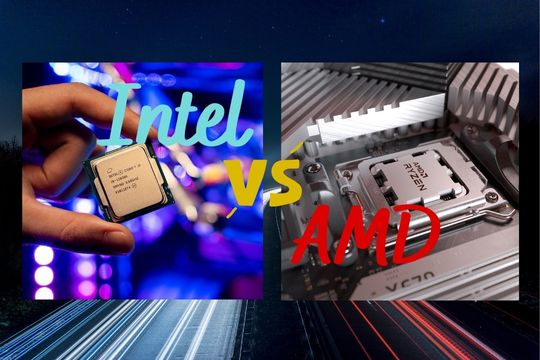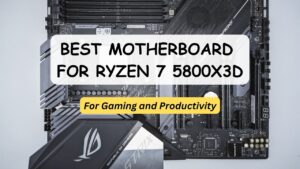Based on revenue, Intel vs AMD both are the world’s most valuable semiconductor chip makers. Intel and AMD are both present in the majority of laptops and computer processors today. As a result, you may have noticed these words written on your laptop. While the suitability of these processors is dependent on the needs and preferences of the users, Intel and AMD are both well-known and dependable brands. Because these processors are not interchangeable, it is critical that you thoroughly understand the terms and features. Intel and AMD are the two major competitors in the CPU market. Although Intel has been a market leader since the early 2000s, there has been a significant shift in the industry in recent years. This does not necessarily imply that Intel has an advantage over all other competitors. Other players may simply be after a different demographic.
It may be difficult for someone who is not technically savvy to choose between these two processors. Though this may appear intimidating, the purpose and target market of each of these processors are distinct. As a result, it is critical that the buyer first understands his or her own budget and requirements before selecting a processor. This article provides a comprehensive overview of what Intel and AMD are, the differences between the two, and which option will best suit your needs. In addition, we’ve addressed the most frequently asked questions by users about AMD vs Intel CPUs.
Intel Processor
Intel stands for “Integrated Electronics.” First and foremost, Intel is a 53-year-old American multinational technology corporation headquartered in Silicon Valley in Santa Clara, California. Robert Noyce developed it. It created the first x86 processor, the Intel 8086. Intel provides processors to computer manufacturers such as Apple, HP, Dell, and Lenovo. They also produce microprocessors, integrated circuits, and other computing and communication devices. Intel became the world’s largest chip manufacturer in 1991 and has maintained that position ever since, capturing a sizable market share.
On a scale of 1-10, Intel processors fall somewhere between 4 and 10. These processors have good CPU performance, and almost all Intel processors include an integrated graphics processor. This processor also runs faster than AMD processors, but at the expense of increased power consumption and battery life. Thus, when battery life is not an issue, newer Intel-powered laptops can be used for short workloads and single-core boosts, particularly in laptops. When it comes to desktop computers, if you want to change the processor, motherboard, or socket compatibility, Intel has fewer options than AMD due to frequent motherboard and chipset changes. Intel Xeon, Intel Core I series, and Intel Core m series are some examples. Intel manufactures processors for laptops, desktops, workstations, and server management. They have processors to meet the needs of the buyer. These are suitable for both personal and commercial applications such as gaming, content creation, IoT, and artificial intelligence. The most popular CPUs are Intel Core processors, which are aimed at mid-range customers.
The following are the primary benefits of using Intel processors:
- Productivity: They offer exceptional performance for both productivity and entertainment.
- Reliability: They are dependable across a wide range of platforms and service requirements.
- Performance: They provide high-performance support for demanding applications.
- Security: They have been strengthened with high-security features.
AMD Processor
AMD is an abbreviation for Advanced Micro Devices. It is a multinational American semiconductor company headquartered in Santa Clara, California. Jerry Sanders, Jack Gifford, and John Carey created it. It began supplying x86 processors as a secondary source manufacturer and competed with Am386. Server processors, workstation processors, embedded and semi-custom processors, laptop processors, desktop processors, and Chromebook processors are all available from AMD. Ryzen is the most popular AMD processor brand. AMD is well-known for producing the world’s most powerful x8 processors.
AMD processors rank 5-10 on a scale of 1-10. It is less expensive than Intel Processors in the same price range. When compared to the current generation Core series, these processors are more efficient. AMD APUs are also a good option due to their good iGPU performance and CPU performance that is comparable to the Core I series. Laptops powered by Ryzen processors often clock lower and less aggressively than Intel-powered laptops, and they often run cooler and longer on battery, so Ryzen-powered laptops can be used when higher iGPU performance and longer battery life are desired. However, older FX series CPUs and A-series APUs should be avoided when building a new Desktop PC due to their higher power consumption and heat output.
AMD, which offers a wide range of processors, is a popular choice for buyers on a tight budget who require high graphic quality and efficiency. It is also a dependable option, similar to its main competitor, and is thus preferred by users who are concerned with graphics and budgeting. If you only want to do normal gaming and everyday use on your desktop or mobile device, the Ryzen APU is the way to go. For more demanding tasks such as video editing and 3D modeling, Ryzen 7 or 9 CPUs or Threadripper should be used. AMD Ryzen, AMD Threadripper, AMD FX-Series, AMD EPYC, AMD Opteron, and AMD Athlon 64 are some examples.
The following are the primary benefits of using AMD processors:
- Graphics: AMD offers exceptional graphics processors designed specifically for gaming.
- Security: AMD’s Enhanced Virus Protection feature can detect malware.
- Lithography: AMD has smaller lithography that does not cause the machine to heat up too often.
- Economical: AMD targets users with limited financial resources.
Differences Between Intel and AMD Processors
Intel vs AMD has long been a source of contention among content creators, PC gamers, and PC builders. Intel and AMD are the market leaders in the CPU market, whether for workstations or gaming. Comparing devices such as laptops today is difficult because they are identical except for the CPU. Different factors such as budget and specific requirements influence the buyer’s decision because the layout and infrastructure are completely different for both.
Processors: Intel vs AMD
When it comes to processor efficiency, the AMD vs Intel debate is heated. When it comes to power consumption, AMD processors outperform Intel processors. However, for a high-end laptop, an Intel-based processor may be a better choice because compatibility is better and the benefits are greater.
Performance: Intel vs AMD
AMD and Intel CPUs provide comparable performance to the others. However, each of these specializes in different areas and caters to different user groups. AMD processors, for example, are known for producing better multi-tasking results. In contrast, Intel CPUs are best suited for single-core tasks.
Cost: Intel vs AMD
When comparing AMD’s Ryzen 3 processor to Intel’s Core i3, the former costs between $95 and $120, while the latter costs between $97 and $160. One of the reasons why ordinary users have begun to switch from Intel to AMD in recent years is the lower price offered by AMD.
Security: Intel vs AMD
Those familiar with the industry have long been concerned about processor vulnerabilities that could ultimately harm users. When it comes to security Intel has 242 publicly disclosed vulnerabilities, while AMD has only 15. Thus, we might say that AMD is more secure than Intel since the gap of vulnerabilities is too huge.
Customer Service: Intel vs AMD
In comparison, Intel has a larger online community presence. Intel provides round-the-clock phone and chats support to its customers. AMD allows its customers to check product details such as warranty. To assist their users, they also have a detailed page with frequently asked questions.
Conclusion
These are the differences that may help a user decide on the most important features and then choose between the two. Before making a decision, we recommend first understanding your needs and then reading the points above to see which option meets the majority of your needs.



